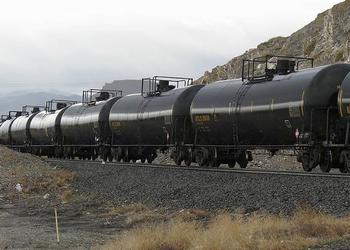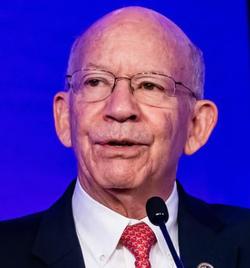
WASHINGTON, DC, September 17, 2019 (ENS) – Two Democratic Congressmen have introduced legislation requiring a comprehensive review of the transport of liquified natural gas, LNG, by rail tank car within the United States.
On April 10, President Donald Trump issued an executive order directing his Transportation Secretary Elaine Chao to authorize the movement of LNG in rail tank cars within 13 months, by May 2020.
Current rules prohibit using pressurized rail tank cars to haul LNG. It is only permitted to move by pipeline, in tank trucks or in portable cargo tank containers.

On June 6, the Pipeline and Hazardous Materials Safety Administration, PHMSA, and the Federal Railroad Administration took steps to allow liquified natural gas to move by rail tank car. The two Congressmen warn that the agencies made this move despite having little information about the possible risks to communities through which the LNG-loaded rail cars will roll.
On September 12, Peter DeFazio, an Oregon Democrat who chairs the House Committee on Transportation and Infrastructure, and Congressman Tom Malinowski, a New Jersey Democrat who is also a member of the committee, introduced in the House of Representatives H.R. 4306, the Protecting Communities from Liquefied Natural Gas Trains Act.
It landed in the Transportation and Infrastructure Committee, and the next day the bill was referred to the Subcommittee on Railroads, Pipelines, and Hazardous Materials.
DeFazio said, “The administration’s absurd plan to allow trains of up to 100 cars filled with LNG to move by rail is extremely reckless.”
“I, along with Congressman Malinowski, have been sounding the alarm on this plan for months,” said DeFazio. “Putting LNG into rail cars and moving it through highly populated communities presents a significant risk to the safety of the public and the environment, with the possibility of catastrophic consequences.”
“Our legislation ensures full disclosure, thorough scientific analysis of risks before the administration can move forward with their proposal,” DeFazio said.

Malinowski added his own warnings to those of his colleague. “Any movement of liquefied natural gas in our country should be closely monitored, with the highest possible safety measures in place, particularly through a densely populated state like New Jersey,” he said.
“The proposed movement of LNG by freight rail companies that are running longer and longer trains with fewer and fewer engineers presents substantial safety risks to communities through which trains pass,” Malinowski cautioned. “A fire chief in my district recently told me that a railcar spill involving LNG would require him to evacuate his entire town of nearly 15,000 people.”
“This bill will ensure that the safety and environmental risks of LNG by rail are thoroughly evaluated, with due consideration of route, speed, brake, and personnel requirements,” Malinowski said.
If it becomes law, H.R. 4306 would require the Federal Railroad Administration and the PHMSA to conduct extensive safety testing of rail tank cars to determine whether existing cars are suitable for the safe movement of LNG.
The bill requires the agencies to consider operating conditions and benefits to the public and environment, and upon completion of these examinations, requires the Government Accountability Office to conduct an independent evaluation to ensure all review requirements have been satisfactorily met.
DeFazio and Malinowski have already had some success in their quest for LNG rail safety.

On June 24, the House passed a DeFazio amendment to an appropriations bill, H.R. 3055, which would prohibit the Secretary of Transportation from finalizing a rulemaking and issuing a special permit to Energy Transport Solutions, ETS, a subsidiary of New Fortress Energy, to allow the movement of multiple sets of 100-car unit trains of LNG in rail tank cars, for use domestically and for export.
“In its never-ending quest to put profit ahead of people, the Trump Administration is now trying to bypass long-standing requirements for transportation of LNG by putting it into 100-car trains that roll through densely populated areas at upwards of 50 miles per hour,” said DeFazio.
“This plan is beyond absurd. Should even one tank car get punctured, the results could be devastating,” DeFazio warned. “My amendment blocks this brazen attempt by the administration. I urge the Senate to follow suit and stop a massive catastrophe before it’s too late.”
To ensure transparency in the process, on June 28, DeFazio and Malinowski sent a letter to PHMSA requesting additional information and an extension of the public comment period on the special permit. While PHMSA agreed to extend the comment period and provided some information, it did not fully comply with their requests.
On August 7, DeFazio and Malinowski sent a follow-up letter requesting that PHMSA comply with the statutory requirements for authorizing a special permit by disclosing adequate information. Their letter questioned the rationale for moving forward with a special permit without conducting a proper safety analysis.
The PHMSA, the agency reviewing the ETS application, cautioned that large releases of LNG due to a breach of the inner tank of a tank car “could pose pool fire, vapor fire and explosion hazards, which pose the highest potential impacts when compared to localized cryogenic hazards.”
But the PHMSA also said that moving one ton of freight by rail would require roughly 70 percent less fuel than moving the same load by truck, and reasoned that moving it by train would reduce environmental damage.
Copyright Environment News Service (ENS) 2019. All rights reserved.
